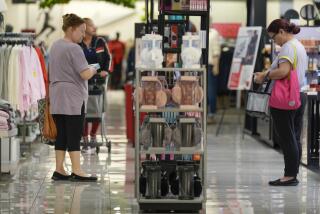September Sales Fall in Many Stores
NEW YORK — Sagging consumer confidence nipped into sales for many of the nation’s biggest retailers in September, leaving department stores hurting but also boosting business for discount and value-oriented merchants.
It was the second straight month that sales at many stores fell below expectations, raising concerns that the holiday season may not be as good as many had expected.
“Consumers are tightening their purses a little,” said Kurt Barnard, a retail consultant and president of Barnard’s Retail Trend Report in Upper Montclair, N.J. “They are spending more carefully and shifting their business to moderate and low-price stores.”
This year began as one of the best in recent history for retailers. A healthy economy, low inflation and unemployment levels and a surging stock market encouraged consumers to spend.
But signs that the economy’s growth may be slowing, coupled with continued volatility in the stock market and political turmoil in Washington, has left many Americans worrying that the country may be nearing a recession.
Retailers also saw their September sales hurt by warmer-than-normal weather and Hurricane Georges, which pounded the Caribbean and the Southeast.
J.C. Penney Co. said sales at its stores open at least a year dropped 6.6%, while Sears, Roebuck & Co. reported a 1.7% decline. Federated Department Stores Inc., which counts Bloomingdale’s and Macy’s among the stores it owns, said sales edged down 0.7%. May Department Stores reported a 4.3% gain.
Wal-Mart Stores Inc., the world’s largest retailer, tipped off the trend among discounters by reporting a 9.5% gain in same-store sales on Tuesday.
Kmart Corp.’s same-store sales jumped 5.6%, Dollar General reported a 8% gain, and Dayton Hudson’s Target unit posted a 6.1% gain.
Specialty clothing stores benefited from the late Labor Day, which pushed the back-to-school shopping season into September from late August a year ago. Sales climbed 14% at Gap and were up 5% at Limited.
Separately Thursday, the Labor Department reported the number of first-time claims for unemployment benefits rose by 11,000 to a seasonally adjusted 300,000, the first increase in four weeks.
Another report showed stocks of unsold goods on wholesalers’ shelves rose 0.9% in August, higher than the 0.2% rise economists expected, as wholesale sales fell 1.2%, the biggest decline since a 1.3% drop in June 1993.
The Commerce Department said the inventory-to-sales ratio, which measures the time goods sit at wholesalers, rose to 1.32 months during August from 1.30 months in July. It was last that high in October 1995.
More to Read
Inside the business of entertainment
The Wide Shot brings you news, analysis and insights on everything from streaming wars to production — and what it all means for the future.
You may occasionally receive promotional content from the Los Angeles Times.








